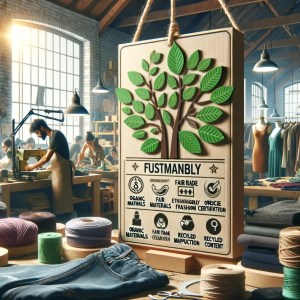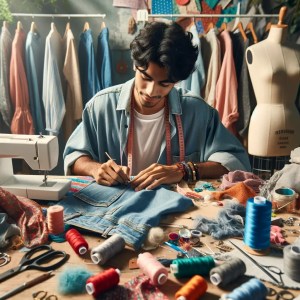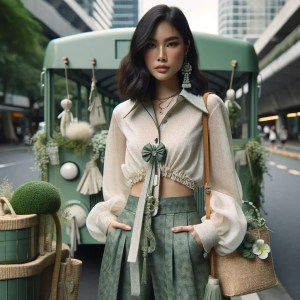- I. Introduction: Embracing Sustainable Fashion
- II. Choosing Sustainable Fashion Brands
- III. Understanding the Impact of Fast Fashion
- IV. The Allure of Second-Hand Clothing
- V. Mindful Consumption in Fashion
- VI. Eco-Friendly Clothing Care
- VII. DIY Fashion: Unleashing Creativity
- VIII. Conclusion
- Join the Simply Sound Society: A Forum for Change
I. Introduction: Embracing Sustainable Fashion

The Rising Trend of Sustainable Fashion
In a world where fashion trends come and go like shifting sands, a new movement is taking root—a movement that’s as much about making a statement as it is about making a difference. Sustainable fashion is the rising star of the fashion industry, and it’s here to stay. This revolution in style is driven by a collective desire to harmonize our love for fashion with our responsibility towards the environment.
Gone are the days when “fast fashion” ruled the runways and our closets. Today, a growing number of fashion enthusiasts are embracing a more conscious approach to dressing. It’s not just about looking good; it’s about feeling good about the choices we make; from the materials we wear to the brands we support.
Balancing Style with Environmental Responsibility
Sustainable fashion is more than a trend; it’s a philosophy. It’s about finding that delicate equilibrium where style and environmental responsibility coexist in perfect harmony. It’s about recognizing that the clothing we wear can have a profound impact on the planet and the people who make our garments.
In this comprehensive guide to sustainable fashion, we’ll explore the exciting world of eco-conscious style. From choosing sustainable fashion brands to understanding the true cost of fast fashion, from the allure of second-hand clothing to mindful consumption practices, we’ll embark on a journey that celebrates fashion’s potential to be a force for good.
Join us as we dive deep into the world of sustainable fashion, where every choice you make becomes a statement of your commitment to a greener, more stylish, and socially responsible future.
II. Choosing Sustainable Fashion Brands

Criteria for Identifying Eco-Friendly Brands
As you step into the realm of sustainable fashion, one of the first steps is to identify brands that align with your values. But what defines an eco-friendly brand? In the world of sustainable fashion, there are some key criteria to look for:
Transparency
Sustainable brands are open about their production processes, materials, and labor conditions. They provide clear information about where and how their clothing is made.
Ethical Practices
Look for brands that prioritize fair wages, safe working conditions, and the welfare of their workers. Certifications like Fair Trade can be a good indicator.
Eco-Friendly Materials
Sustainable fashion brands use materials that have a lower environmental impact. This can include organic cotton, recycled fabrics, and innovative sustainable materials like Tencel or Piñatex (made from pineapple fibers).
Circular Fashion
Some brands adopt a circular fashion model, where they design products with longevity in mind, promote repair and recycling, and take back old garments for recycling or upcycling.
The Importance of Transparency and Ethical Practices in Fashion
Transparency and ethical practices in the fashion industry are essential for creating a more sustainable and fair world. When brands are transparent about their supply chains and production processes, consumers can make informed choices that support ethical practices. It's a step towards ensuring that the people who make our clothes are treated with dignity and paid fairly.
Spotlight on Leading Sustainable Fashion Brands
In the vast landscape of fashion, several brands have emerged as leaders in sustainability. They set the bar high when it comes to eco-conscious practices. Some of these trailblazing brands include Patagonia, EILEEN FISHER, Stella McCartney, and Reformation, to name a few. These brands not only prioritize sustainability but also offer stylish and trendy clothing options that cater to diverse tastes.
III. Understanding the Impact of Fast Fashion

The Environmental and Social Costs of Fast Fashion
The term "fast fashion" has become synonymous with the rapid production and consumption of clothing. It's a model that thrives on quick turnovers, frequent collections, and low prices. However, this convenience comes at a significant cost to the environment and society.
Fast fashion contributes to a range of environmental problems, including:
Resource Depletion
The production of fast fashion relies heavily on natural resources like water and land. It leads to overuse and depletion of these resources, often in regions where they are already scarce.
Waste Generation
The fashion industry generates vast amounts of textile waste. Cheap, poorly made garments often end up in landfills, where they can take years to decompose.
Chemical Pollution
The use of toxic chemicals in dyeing and finishing textiles pollutes waterways and harms ecosystems. It also poses health risks to workers.
The Lifecycle of Fast Fashion Products
Understanding the lifecycle of fast fashion products can be eye-opening. These garments typically follow a linear path: production, consumption, disposal. This linear model is unsustainable and has far-reaching consequences.
Production
Fast fashion brands prioritize speed and low cost in production. This often means outsourcing to countries with lax labor and environmental regulations. Workers in these factories are often paid poorly and subjected to unsafe working conditions.
Consumption
Fast fashion encourages frequent shopping for new items, promoting a culture of disposability. Clothes are worn a few times and discarded when they go out of style.
Disposal
The fate of discarded fast fashion clothing is grim. Many end up in landfills, where they contribute to environmental degradation. Others are incinerated, releasing harmful pollutants into the air.
Alternatives to Fast Fashion Consumption
Breaking free from the cycle of fast fashion is a powerful step towards sustainability. Here are some alternatives to consider:
Buy Less, Choose Well
Instead of frequent shopping sprees, focus on buying high-quality, timeless pieces that you'll cherish for years.
Support Sustainable Brands
Opt for brands that prioritize sustainability and ethical practices. These brands often offer durable clothing made from eco-friendly materials.
Second-Hand Shopping
Explore thrift stores, consignment shops, and online platforms for second-hand clothing. Vintage pieces can add unique flair to your wardrobe.
Clothing Swaps
Organize clothing swaps with friends or in your community. It's a fun way to refresh your wardrobe without buying new items.
Repair and Upcycle
Learn basic sewing skills to repair clothing, and get creative with upcycling projects to give old garments new life.
By embracing these alternatives, you can reduce your contribution to the fast fashion industry and support a more sustainable approach to fashion.
IV. The Allure of Second-Hand Clothing

The Benefits of Shopping Second-Hand
Second-hand clothing, often referred to as thrifted or vintage fashion, has gained popularity for several compelling reasons:
Environmental Impact
Choosing second-hand clothing reduces the demand for new production. This, in turn, reduces the environmental footprint associated with clothing manufacturing, including resource use and pollution.
Unique Style
Vintage clothing offers a sense of individuality. You can discover one-of-a-kind pieces that set your style apart from mass-produced fashion.
Affordability
Second-hand clothing is often more affordable than new items, making it an attractive option for budget-conscious shoppers.
Quality and Durability
Many vintage pieces were made with high-quality materials and craftsmanship, ensuring their longevity.
Where to Find Quality Second-Hand Fashion
Thrift Stores
Thrift stores are treasure troves of second-hand clothing. They offer a wide variety of styles and sizes at affordable prices.
Consignment Shops
Consignment shops often carry gently used, high-end clothing. You can find designer pieces and well-maintained items.
Online Resale Platforms
Websites and apps dedicated to second-hand fashion, such as Poshmark, Depop, and ThredUp, provide a convenient way to shop for pre-loved clothing.
Vintage Boutiques
Vintage boutiques curate collections of unique and retro clothing. They are ideal for those looking for distinctive fashion statements.
Garage Sales and Flea Markets
These local events can yield hidden gems. You can haggle for deals and discover unexpected treasures.
Incorporating Vintage Pieces into Modern Wardrobes
Integrating vintage clothing into your modern wardrobe can be an exciting and creative endeavor. Here are some tips:
Mix and Match
Pair vintage items with contemporary pieces to create a balanced look that's both timeless and trendy.
Accessorize
Vintage accessories like scarves, hats, and jewelry can add a vintage touch to any outfit.
Tailoring
Consider getting vintage garments tailored to fit your body perfectly. A well-fitted piece can elevate your style.
Layering
Experiment with layering vintage items, such as blazers or cardigans, to create unique ensembles.
Styling
Research different eras and fashion movements to find inspiration for styling your vintage pieces.
By embracing second-hand clothing, you not only reduce your fashion footprint but also add a touch of history and individuality to your wardrobe.
V. Mindful Consumption in Fashion

Adopting a Thoughtful Approach to Buying Clothes
In a world of fast fashion and ever-changing trends, adopting a mindful approach to buying clothes is a refreshing and responsible choice. Here's how you can do it:
Plan Your Purchases
Before you go shopping, take some time to assess your wardrobe. Identify what you truly need and make a list. Stick to this list to avoid impulse purchases.
Quality Over Quantity
Instead of buying many inexpensive items, invest in high-quality pieces that will last longer and withstand wear and tear.
Consider Versatility
Look for clothing items that can be mixed and matched with other pieces in your wardrobe. Versatile items give you more outfit options.
Ethical Brands
Support brands that prioritize ethical and sustainable practices. Look for certifications like Fair Trade and B Corp to ensure responsible production.
Slow Fashion
Embrace the concept of "slow fashion," which focuses on timeless styles and sustainable materials. It's about buying with the intention of long-term use.
Building a Sustainable and Versatile Wardrobe
Creating a sustainable wardrobe is about curating a collection of clothing that aligns with your values and lifestyle. Here's how to build one:
Assess Your Style
Determine your personal style preferences, whether it's casual, formal, bohemian, or minimalist. This will guide your clothing choices.
Capsule Wardrobe
Consider creating a capsule wardrobe, a collection of essential pieces that can be mixed and matched. It simplifies your choices and reduces clutter.
Quality Basics
Invest in high-quality basics like t-shirts, jeans, and shoes. These are the foundation of your wardrobe and should be durable.
Statement Pieces
Add a few statement pieces that showcase your unique style. These can be vintage finds or artisanal items that tell a story.
Repair and Care
Learn basic clothing repair skills like sewing buttons and patching small holes. Proper care, such as following care labels and air-drying, extends the life of your clothes.
Donate or Sell
When you decide to part with clothing, consider donating to charities or selling items online. This gives your clothes a second life.
The Role of Consumer Demand in Shaping Fashion Trends
Consumers have the power to influence the fashion industry's direction. By demanding sustainable and ethical practices, you contribute to positive change. Here's how:
Support Sustainable Brands
Choose to buy from brands that prioritize sustainability. Your purchases signal to the industry that eco-conscious fashion is in demand.
Advocate for Transparency
Encourage brands to be transparent about their supply chains and practices. Ask questions and demand accountability.
Educate Others
Share your knowledge about sustainable fashion with friends and family. Awareness can lead to more informed choices.
Join Fashion Movements
Participate in fashion movements and events that promote sustainability. Attend clothing swaps, eco-fashion shows, or sustainable fashion fairs.
Social Media Influence
Use social media platforms to highlight sustainable fashion brands and practices. Your voice can reach a wide audience.
As consumers, we have the opportunity to reshape the fashion industry into one that values ethical and sustainable practices. By making conscious choices, we contribute to a future where fashion is both stylish and responsible.
VI. Eco-Friendly Clothing Care

Tips for Sustainable Laundry Practices
When it comes to sustainable fashion, caring for your clothing is just as important as making eco-conscious purchasing decisions. Here are some tips for sustainable laundry practices:
Wash with Care
Use a front-loading washing machine, which typically uses less water and energy compared to top-loading machines. Wash your clothes in cold water whenever possible, as it reduces energy consumption.
Full Loads Only
Wait until you have a full load of laundry before running the machine. This maximizes efficiency and minimizes water and energy waste.
Choose Eco-Friendly Detergents
Opt for environmentally friendly detergents that are free of harsh chemicals and phosphates. Look for detergent brands with eco-certifications.
Skip the Dryer
Air-drying your clothes not only conserves energy but also extends the lifespan of your garments. Invest in a drying rack or use a clothesline when the weather permits.
Avoid Fabric Softeners
Most fabric softeners contain synthetic chemicals that are harmful to the environment. Instead, use alternatives like vinegar or wool dryer balls to soften your laundry.
Extending the Life of Your Wardrobe
Sustainable fashion is about longevity, and there are several ways to extend the life of your clothing:
Proper Storage
Store your clothes in a cool, dry place away from direct sunlight. Use appropriate hangers and avoid overpacking your wardrobe.
Gentle Washing
Follow care labels on clothing items to ensure proper washing and avoid damage. Turn delicate items inside out before washing.
Repair and Alter
Don't discard clothing with minor damage. Learn basic sewing skills to repair small tears, loose buttons, or loose hems. Consider alterations for items that no longer fit perfectly.
Rotate Your Wardrobe
Give your clothes a break. Rotate your wardrobe seasonally to reduce wear and tear on specific items.
Avoid Over-Washing
Not every garment needs to be washed after one wear. Consider spot-cleaning or airing out clothes to reduce the frequency of washing.
Pilling Prevention
To prevent pilling on sweaters and knits, store them folded rather than hanging. Use a fabric shaver to remove pills.
Natural and Homemade Solutions for Clothing Care
Eco-friendly clothing care extends to the products you use. Consider these natural and homemade solutions:
Natural Stain Removers
Lemon juice, baking soda, and white vinegar can effectively remove stains from clothing. Apply them directly to stains before washing.
Homemade Fabric Freshener
Create your fabric freshener by mixing water with a few drops of essential oil in a spray bottle. Use it to refresh clothes between washes.
DIY Laundry Detergent
Make your laundry detergent using simple ingredients like soap flakes, washing soda, and essential oils. This reduces packaging waste and chemical exposure.
Natural Deodorizing
To remove odors from clothing, hang them outside in the fresh air and sunlight. The sun's UV rays naturally disinfect and deodorize.
By incorporating these sustainable laundry practices and natural solutions into your clothing care routine, you contribute to the longevity of your wardrobe and minimize your environmental footprint.
VII. DIY Fashion: Unleashing Creativity

Upcycling and Customizing Clothes
Embracing sustainable fashion isn't just about buying eco-friendly clothing; it's also about getting creative and upcycling your wardrobe. Upcycling involves repurposing or transforming old clothing into something new and stylish. Here's how to unleash your creativity through upcycling:
Repurpose Old Clothes
Take a look at your closet and identify items you no longer wear. Instead of discarding them, think about how you can repurpose them into something fresh and exciting. For example, turn an old pair of jeans into stylish cutoff shorts.
Customize with Embellishments
Add unique flair to your clothing by embellishing them with beads, sequins, patches, or embroidery. This personal touch not only revitalizes your wardrobe but also makes each piece one-of-a-kind.
Tie-Dye and Dye Techniques
Experiment with tie-dye or dip-dye techniques to breathe new life into plain white clothing. Create vibrant patterns and colors to express your style.
Patchwork Creations
Combine fabric scraps or old clothing pieces to create patchwork designs on jackets, jeans, or bags. This technique allows you to make use of various textiles and create a distinctive look.
DIY Distressing
Give your jeans or denim jackets a trendy distressed look by carefully using sandpaper, scissors, or a cheese grater. Distressing adds character to your clothing.
Easy DIY Fashion Projects for Beginners
If you're new to DIY fashion, here are some simple projects to get you started:
T-Shirt Upcycling
Turn old T-shirts into crop tops, tank tops, or off-the-shoulder styles. Cut and tie knots to create unique designs.
Customized Denim
Use fabric paint, stencils, or fabric markers to add artistic designs to your jeans or denim jackets. You can create motifs, quotes, or abstract patterns.
Beaded Accessories
Transform plain accessories like headbands or belts by adding beads or sequins. You can create intricate or minimalistic designs depending on your style.
Sweater Mittens
Upcycle old sweaters into cozy mittens. Use the sweater's cuffs for the mittens' cuffs and repurpose the body for the hand part.
Tote Bag Creations
Customize plain tote bags by painting or stenciling them with your favorite designs. These bags are not only eco-friendly but also practical.
The Joy and Satisfaction of Creating Your Own Style
DIY fashion isn't just about sustainability; it's also a creative outlet that allows you to express your unique style. When you upcycle and customize your clothing, you:
As you embark on your DIY fashion journey, remember that it's all about having fun and embracing your creativity. Whether you're a seasoned DIY enthusiast or a beginner, there's no limit to the possibilities when it comes to upcycling and customizing your wardrobe.
VIII. Conclusion

The Collective Impact of Sustainable Fashion Choices
In the world of fashion, every choice you make as a consumer has a ripple effect. By embracing sustainable fashion practices, you become a part of a larger movement that advocates for positive change. Your individual choices, when multiplied by millions of like-minded individuals, can lead to significant transformations in the fashion industry and beyond.
Reducing Environmental Impact
Your decision to support eco-friendly brands and practices contributes to the reduction of environmental harm caused by the fashion industry. It minimizes the depletion of natural resources, decreases pollution, and mitigates the carbon footprint associated with clothing production.
Promoting Ethical Practices
Supporting brands that prioritize ethical and transparent manufacturing processes helps improve working conditions for garment workers worldwide. It sends a message to the industry that exploitation and unfair labor practices are unacceptable.
Influencing Fashion Trends
Consumer demand plays a pivotal role in shaping fashion trends. As more people opt for sustainable fashion, the industry responds by incorporating eco-friendly materials and practices into mainstream collections.
Encouraging Innovation
Sustainable fashion fosters innovation in materials, production methods, and recycling technologies. It inspires fashion designers and entrepreneurs to create innovative solutions that benefit both consumers and the planet.
The Future of Fashion: Sustainable and Stylish
The future of fashion is undoubtedly green. Sustainability is no longer a niche movement but a driving force in the industry. As consumers become more conscious of their fashion choices, brands are responding by reimagining the way they create and market clothing. Here's what the future of fashion looks like:
Circular Fashion Economy
The concept of a circular fashion economy is gaining momentum. It emphasizes recycling, upcycling, and reusing clothing to extend their lifespan. Brands are increasingly adopting circularity principles.
Transparency and Accountability
Brands are expected to become more transparent about their supply chains and manufacturing processes. Consumers demand to know where and how their clothes are made.
Innovation in Materials
Sustainable materials such as plant-based fibers, recycled textiles, and lab-grown fabrics are becoming more mainstream. These materials offer eco-friendly alternatives to traditional textiles.
Slow Fashion Movement
Slow fashion, characterized by fewer, high-quality pieces that are made to last, is gaining popularity. It contrasts with the disposable nature of fast fashion.
Consumer Empowerment
Consumers are becoming more empowered and educated about their fashion choices. They are driving the demand for sustainable options and holding brands accountable for their actions.
Encouraging a Fashion Revolution for a Greener Future
As we conclude our exploration of sustainable fashion, we invite you to be a part of a fashion revolution—one that prioritizes the planet and its people. Your choices matter, and your influence can catalyze change in the fashion industry.
Support Sustainable Brands
Seek out and support fashion brands that align with your values of sustainability and ethics. When you choose eco-friendly options, you send a clear message to the industry.
Educate and Advocate
Share your knowledge and passion for sustainable fashion with friends and family. Advocate for conscious consumerism and the importance of ethical fashion practices.
Embrace Your Unique Style
Sustainable fashion is not about sacrificing style; it's about expressing your unique tastes and values through clothing. Celebrate your individuality and use fashion as a creative outlet.
Extend the Lifespan of Clothing
Care for your garments and extend their lifespan through proper maintenance. Repair, upcycle, and donate clothing to keep them out of landfills.
Stay Informed
Continue to educate yourself about sustainable fashion practices and stay updated on the latest developments in the industry. Your knowledge is a powerful tool for change.
In this fashion revolution, your wardrobe becomes a statement of your commitment to a greener, more responsible future. Together, we can transform the fashion industry into one that not only values style but also prioritizes sustainability and ethical practices. Let's create a fashion world that benefits both the wearer and the planet.
Join the Simply Sound Society: A Forum for Change
Connect with like-minded individuals committed to sustainability in the Simply Sound Society. Share experiences, learn from others, and engage in meaningful discussions about green living. Join us here and be a part of a community that's shaping a greener, more sustainable world.
Join the Simply Sound Society: Your Community for Sustainable Living
Are you passionate about making a difference in the world through sustainable living? Do you seek a community where ideas, experiences, and insights on eco-friendly practices are shared and celebrated? Look no further — the Simply Sound Society is your destination!

Why Join Simply Sound Society?
- Connect with Like-Minded Individuals: Engage with a community that shares your enthusiasm for environmental stewardship and green living. Here, every member is committed to making a positive impact.
- Exchange Ideas and Learn: Whether you're a seasoned green warrior or just starting your sustainable journey, there's always something new to learn. Share your experiences, pick up new tips, and expand your understanding of sustainability.
- Stay Informed and Inspired: Keep up to date with the latest trends, technologies, and practices in sustainable living. Our community brings together diverse perspectives and the latest insights in one dynamic forum.
- Participate in Engaging Discussions: Dive into lively discussions that challenge, inspire, and motivate. From debating the best eco-friendly home practices to brainstorming community initiatives, every conversation is an opportunity to grow and contribute.
- Access Exclusive Content and Resources: Members of the Simply Sound Society get first-hand access to specially curated content, resources, and events. Enhance your knowledge and skills with our exclusive offerings.
- Be Part of a Supportive Network: Embarking on a path to sustainability can be challenging, but you don't have to do it alone. Our community provides support, encouragement, and a sense of belonging.
How to Join
Becoming a member is easy! Just visit [Simply Sound Society’s webpage] and sign up. Whether you're looking to make small changes in your daily life or take on larger environmental projects, the Simply Sound Society is here to support and guide you every step of the way.
Make a Difference, Together
In the Simply Sound Society, we believe that collective action is the key to driving meaningful change. Join us today and be part of a movement that is not just about living green, but also about nurturing a sustainable future for all. Your voice, your actions, and your commitment can make a significant difference. Let's embark on this journey together!















